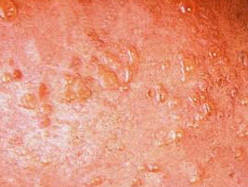 |
|
|
The Skin is a window on the health of the body and the point of contact between the body and the outside world. Many illnesses and conditions can show up in skin changes. Food allergies may show up as skin rashes. (Dermatitis just means an inflammation of the skin) Interestingly animals including cats and dogs are very susceptible to skin rashes provoked by foods.
Urticaria (hives) The skin is a common target organ for allergic responses to food. Acute urticaria is characterized by itchy, transient, red raised lesions, sometimes accompanied by localized swelling (angioedema). Food allergy accounts for up to 20 percent of cases of acute urticaria and is a true allergy mediated by antibodies (IgE) specific to food protein. The skin lesions usually occur within one hour of eating or contact with the food.
Atopic disease - which is a condition where an inherited tendency can render a person susceptible to allergies which may manifest as skin rash on eczema, as a respiratory problem in asthma and it is thought that migraine may also be related.
In infantile eczema the atopic reaction can be provoked by food substances. The infant gut is easier to penetrate by food molecules and so the baby is more vulnerable to absorbing antigens. Cows milk protein is an important factor especially if this is used as a supplement or instead of breast milk in a susceptible baby. Please note this is the protein which causes the reaction and this is not related to lactose. Substitutes such as goats milk or soya can be used but some children are also allergic to these. Specially prepared milks in which the proteins are broken down into smaller molecules (eg pregestimil) can be used in some cases but are very expensive. Breast milk is far the best. Also allergy-provoking foods such as milk, eggs, fish and peanuts should be avoided in the breast-feeding mother’s daily diet. Avoidance of solid foods in babies up to 6 months of age followed by the careful introduction of the potential allergy-provoking foods such as cow’s milk, wheat and peanut at 12 months, and eggs and fish only being introduced after 18 months. Up to a third of infantile eczema is food allergy related and food additives and colourings may also aggravate eczema in older children. In addition adverse reactions to citrus fruit, tomatoes, pineapples and Marmite, are common in patients with eczema
Many general or systemic diseases have also a skin manifestation, For example Coeliac disease which is basically an intolerance to gluten, has an intestinal set of symptoms and a generalised symptomatology which can include joint and skin problems. The skin reaction can be seen as dermatitis herpetiformis which is a chronic recurring itchy rash.
|
|
|
Dermatitis herpetiformis is a chronic inflammatory disease that produces lesions that burn and itch intensely. This is a close-up of dermatitis herpetiformis lesions. The lesions are red (erythematous) and may be slightly raised (papular), form small pus-filled areas (pustules), or there may be blisters (vesicles). The disease develops suddenly and may last from weeks to months. It may occur in association with gluten (wheat) sensitivity and allergy. |
|
|
|
Dermatitis herpetiformis can be treated with a drug known as dapsone which alleviates the symptoms but the avoidance of gluten is also essential. It is a condition which is part of the auto-immune group of disorders. |


